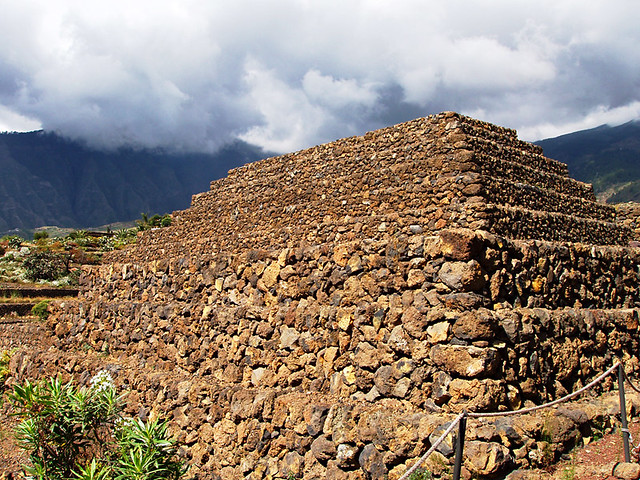The structure on the ancient lava field holds my gaze. I stare at its lumpy surface. I can hear the basaltic bombs whispering, possibly revealing the answer to a mystery.
The unsophisticated circular construction changes everything. It changes everything because it exists.
Ignoring bleached bony human remains at my feet, I turn my back on the ebony rocks and look down the valley. Its steep walls guide my eyes to the sea and beyond, where a white triangle peaking above a dense bank of clouds betrays the existence of another island.
Almost directly in line with my valley, below the white mountain, is another valley. Another valley with ancient constructions also built from rough volcanic rocks.
Whereas the ones behind me are matter-of-factly explained in neat little panels that no-one argues with, the stones across the ocean cause the faces of men to redden. They have the power to provoke abusive taunts and mockery.
Why is that?
The Pyramids of Guimar in Tenerife are an enigma and a source of controversy. Islanders are split between those who say they are the sun-worshipping temples of the Canary Islands’ original inhabitants, the Guanches, and those who claim they were just rubble, stones piled in heaps by farmers.
The famous anthropologist Thor Heyerdahl believed they were step pyramids and further evidence of links between ancient civilisations in the Old and New Worlds. He dedicated his life to rebuilding them after they were ‘discovered’ in the 1990s.
The Guimar Pyramids have fascinated me since I first learned of their existence. I admit it, I want to believe they are real. Many don’t. Not only do people not want to believe the pyramids are real, some become furious at any suggestion that they might be.
One time, a neighbour arrived at our gate angrily brandishing a magazine article written by Andy that merely suggested people should keep an open mind.
Why they arouse such emotion is a mystery.
Why they arouse such emotion amongst a people who now say they revere the Guanches and erect monuments to them across the island is ironic. Why they arouse such emotion when the same people undertake a pilgrimage in their thousands to honour a re-enactment of Guanche shepherds meeting the Virgin Mary years before a Spaniard had set foot on the island is bewildering.
The idea that an ancient race who mummified their dead and worshipped the sun would build temples is laughable to some who happily commemorate a meeting where a wooden figurehead from a ship apparently froze a man’s arm with a stare and made another turn a blade on himself.
Mysteries within mysteries.
I turn my attention back to the hard, unfriendly volcanic landscape in the valley of Agaete on Gran Canaria. A valley of seven hundred tombs dating from as far back as thirteen hundred years ago.
Seven hundred tombs, some of which are in neat, truncated cone shapes atop a bed of lava, the rough rock being carefully laid on top of each other to create a rounded exterior wall that is almost smooth.
People on Tenerife and the other Canary Islands mock the very idea that the Guanches could construct a temple of rocks.
And yet here I am sitting in a beautiful valley looking in wonderment across an ancient cemetery made up of circular tombs built by the Ancient Canarians.
Nobody’s mocking these.
Why is that?
The Pyramids of Guimar are located in the valley of the same name on Tenerife. The Gran Canaria tombs are found in the Maipés Parque Arqueológico in Agaete. If you get a chance visit both and open your mind.
Jack is co-owner, writer and photographer for BuzzTrips and the Real Tenerife series of travel websites as well as a contributor to lots of other places. Follow Jack on Google+








Fascinating stuff. Must get down there one of these days …
The islands are fascinating Phil. Being at the crossroads of travel to the New World has left some interesting legacies. Of course this all gets overshadowed by the fact that you can sunbathe every month of the year 🙂
This looks amazing. I had no idea there were pyramids in the Canary Islands too!
It’s a controversial subject. Possibly partly because some were flattened to make way for housing and who wants to admit tearing down a piece of history to build an apartment block?
The Guimar ones are triky to believe in as they found Victorian pottery when they excavated below the pyramids. If you viit La Palma you still see walled areas full of rocks used to store the rubble from the fields: A pile of rocks supported by a wall is the most efficient way to get rid of it.
Yes, I’ve heard that one a lot Alex. The attitude to the pyramids is almost as as fascinating as the pyramids themselves. Certainly on Tenerife these piles of rocks that look like step pyramids only occur in certain places, coincidentally in places where there was a strong Guanche presence. Of course we’ll never know about the one in the La Orotava Valley as it was demolished to make way for hotels. The ones in Guimar would now be a housing development if Thor Heyerdahl hadn’t stepped in.
The cemetery in GC shows that the Ancient Canarians did actually build monuments of sorts and step pyramids aren’t that uncommon amongst sun worshippers. The point being that the idea of their existence isn’t fantastical – and yet it’s treated as though it is. I know about the La Laguna research but, for a number of reasons, I think there needs to be an objective study by people from outside of the islands.
Until some reputable body does and comes up with definitive evidence one way or the other, the debate continues 🙂